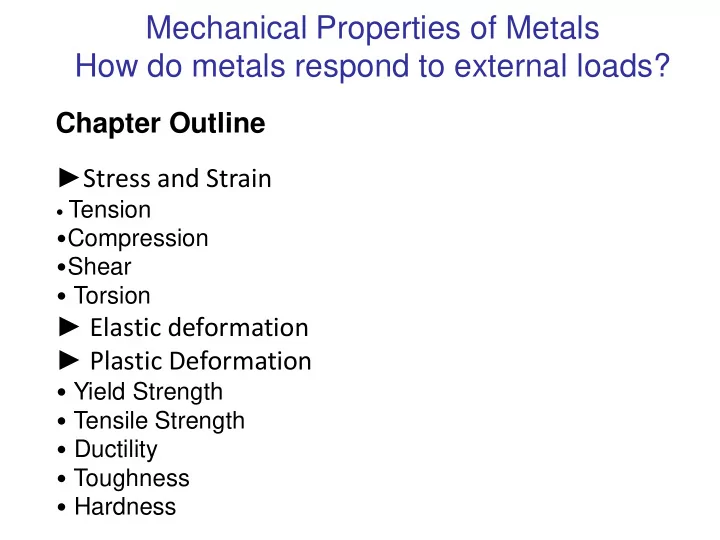

Mechanical Properties of Metals How do metals respond to external loads? Chapter Outline ► Stress and Strain • Tension • Compression • Shear • Torsion ► Elastic deformation ► Plastic Deformation • Yield Strength • Tensile Strength • Ductility • Toughness • Hardness
Introduction To understand and describe how materials deform (elongate, compress, twist) or break as a function of applied load, time, temperature, and other conditions we need first to discuss standard test methods and standard language for mechanical properties of materials.
Concepts of Stress and Strain (tension and compression ) To compare specimens of different sizes, the load is calculated per unit area. Engineering stress: σ = F / A o F is load applied perpendicular to specimen cross-section; A 0 is cross-sectional area (perpendicular to the force) before application of the load. Engineering strain: ε = (Δl / l o ) × 100 % Δl is change in length, l o is the original length. These definitions of stress and strain allow one to compare test results for specimens of different cross- sectional area A 0 and of different length l 0 . Stress and strain are positive for tensile loads,negative for compressive loads
Types of loading Tensile compressive Torsion Shear
Hardness (I) Hardness is a measure of the material’s resistance to localized plastic deformation (e.g. dent or scratch) A qualitative Moh’s scale, determined by the ability of a material to scratch another material: from 1 (softest = talc) to 10 (hardest = diamond). Different types of quantitative hardness test has been designed (Rockwell, Brinell, Vickers, etc.). Usually a small indenter (sphere, cone, or pyramid) is forced into the surface of a material under conditions of controlled magnitude and rate of loading. The depth or size of indentation is measured. The tests somewhat approximate, but popular because they are easy and non-destructive (except for the small dent).
Hardness • Resistance to permanently indenting the surface. • Large hardness means: -- resistance to plastic deformation or cracking in compression. -- better wear properties. apply known force measure size e.g., of indent after 10 mm sphere removing load Smaller indents d D mean larger hardness. most brasses easy to machine cutting nitrided plastics Al alloys steels file hard tools steels diamond increasing hardness
• Rockwell – No major sample damage – Each scale runs to 130 but only useful in range 20-100. – Minor load 10 kg – Major load 60 (A), 100 (B) & 150 (C) kg • A = diamond, B = 1/16 in. ball, C = diamond • HB = Brinell Hardness – TS (psia) = 500 x HB – TS (MPa) = 3.45 x HB
Hardness (II)
Both tensile strength and hardness may be regarded as degree of resistance to plastic deformation. Hardness is proportional to the tensile strength – but note that the proportionality constant is different for different materials. For most steels TS (MPa) = 3.45 x HB
Hardness tests are performed more frequently than any other mechanical test for several reasons: 1. Inexpensive and simply performed 2. No special specimen need be prepared 3. Nondestructive type of tests ( a small indentation is the only deformation) 4. Other mechanical properties may be estimated from hardness data.
True Stress & Strain Note: S.A. changes when sample stretched 1 F A T i T • True stress ln ln 1 T i o T • True strain Adapted from Fig. 6.16, Callister & Rethwisch 8e.
Hardening • An increase in y due to plastic deformation. large hardening y 1 small hardening y 0 • Curve fit to the stress -strain response: hardening exponent: n n = 0.15 (some steels) T K T to n = 0.5 (some coppers) “true” strain: ln( L / L o ) “true” stress ( F / A )
Variability in Material Properties • Elastic modulus is material property • Critical properties depend largely on sample flaws (defects, etc.). Large sample to sample variability. • Statistics – Mean 1 n 2 2 x i x s – Standard Deviation n 1
Design or Safety Factors • Design uncertainties mean we do not push the limit. • Factor of safety, N Often N is between y 1.2 and 4 working N • Example: Calculate a diameter, d , to ensure that yield does not occur in the 1045 carbon steel rod below. Use a factor of safety of 5. d y 1045 plain working carbon steel: N L o = 310 MPa y 220,000 N TS = 565 MPa d 2 / 4 F = 220,000N d = 0.067 m = 6.7 cm
What are the limits of “safe” deformation?
Design stress : σ d = N* σ c where σ c = maximum anticipated stress, N is the “design factor” > 1. Want to make sure that σ d < σ y Safe or working stress : σ w = σ y /N where N is “factor of safety” > 1. For practical engineering design, the yield strength is usually the important parameter
Recommend
More recommend